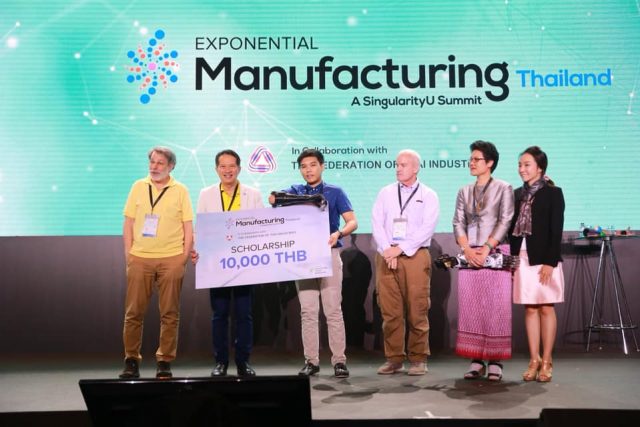
The most touching moment of the Exponential Manufacturing Thailand 2019 summit had to be when a young man by the name of Narut tried on his new prosthetic arm for the first time. The arm, which was 3D printed, was designed in part by Narut with assistance from both e-NABLE, a global community collaborating to make free 3D printed prosthetic limbs, and Thai Reach, the local chapter of e-Nable.
But that wasn’t all. Narut was also presented with a scholarship for THB10,000 from Supant Mongkolsuthree, Chairman of the Federation of Thai Industries, to further his studies.
“Today shows e-Nable can make a big difference. Narut spent 20 years trying to find his arm and thanks to the program, it finally happened. The key was this was a well-designed product that anyone could access and print,” Jon Schull, Founder of e-NABLE, explained. “Narut found a design he liked, but then added his own improvements to the design. This is what makes the movement unique. Anyone can contribute.”
Creating a better world with 3D printing
The e-Nable project started on the back of a YouTube comment. It has since grown into a global volunteer effort. Schull has witnessed how the use of exponential technology leads to an increase in what people can accomplish.
“We wanted to create a better world for humans by humans and 3D printing can help do this. It is easy to share designs. All it takes is a single e-mail. This creates a sharing community that empowers people no matter where they are in the world,” Schull stated. “e-Nable and Thai Reach are an example of how the internet and ordinary people can share thoughts and innovations that can become extraordinary.”
This concept is engrained in everything e-Nable does. With a global network of chapters, including Thai Reach in Thailand, Schull noted that the organization is a true convergence of exponential technologies and emerging trends providing people a base on which they can be built upon, even if their ideas are not fully formed.
“Incomplete technology or innovation is substantially better than nothing. More importantly, collaboration allows people to contribute to the building of incomplete technology to help make it better,” Schull reported. “It can continue to address the needs of people this way even if the product isn’t finished.”
This is especially true when it comes to prosthetics and other devices. For those living in underserved or underprivileged areas, devices created thanks to e-Nable designs and a 3D printer empowers them with something they would otherwise not have access to. This is what shows the true potential of 3D printing.

































